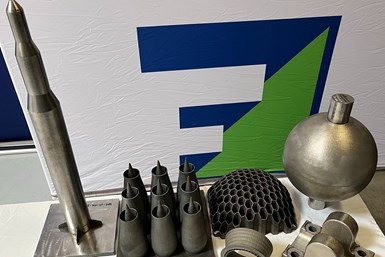Be a “DED Head?” AM Limitations – Eliminated
DED systems make it easier for manufacturers to integrate additive manufacturing by offering multiple capabilities as well as easy accessibility.
More design freedom. More flexibility. More applications. Additive manufacturing (AM) is offering more for manufacturers every day. An AM technology called directed energy deposition (DED) provides new capabilities for forming, enhancing and repairing parts — making it an exciting new tool in the always growing AM toolbox.
Melanie Lang, CEO and co-founder of FormAlloy, joined our favorite professors — Dr. Tom Kurfess and Dr. Kyle Saleeby — to chat about DED technology and its accessibility for non-professors. DED uses focused thermal energy to fuse materials by melting as they are being deposited. It has distinct capabilities that set it apart from binder jetting and powder bed fusion technologies.
“It is very exciting technology because it can be used in a variety of different ways, since you are putting material where you need it — from repair and enhancement to forming,” Lang explains. “It is always nice to have multitool applications that can do more than one thing.”
FormAlloy’s machines enable operators to vary materials in each part layer and create multimaterial parts. Operators can also choose which way to build parts, giving them more design freedom and flexibility, and enabling more complex geometries.
Beyond material and design flexibility, DED systems are built with extensive monitoring and control capabilities. “We are able to provide excellent surface finish and high build speeds largely because of our monitoring and control systems,” Lang explains. “We have eyes and ears on exactly what is happening in the machine and in the melt pool, so we can easily identify the optimal process parameters using sensors.”
DED systems were designed to run, operate and be repeatable much like a machine tool, making them easier for machinists to adopt. “These machines are not just for material scientists and Ph.Ds. We build tools meant for the workforce we have now — and that includes CNC operators,” Lang adds.
In addition to an intuitive operating system that will be familiar to anyone who has used a CNC machine, DED systems were also built to make data collection easy. The machine can easily provide raw data for scientists, as well as a simple build report for machine operators and project managers that summarizes what happened in the build and highlights anomalies.
While many shops have been hesitant to adopt AM, DED systems make it easier to integrate by offering multiple capabilities as well as easy accessibility. Maybe it’s time to retire those objections and become a DED head.
Watch the discussion at imts.com/watchdedhead. Discover more about AM fAMily at the Formnext Forum Austin, Aug. 28-30, in Austin, Texas, and at formnextforum.com.
Related Content
-
Daimler, OMIC Evaluate Wire-Fed DED for Moldmaking
3D printing a core and cavity on machine from Gefertec, followed by machining, allowed for a complete mold tool to be produced in three days.
-
What Is the Role of Directed Energy Deposition (DED)? We Are Still Discovering It
The applications go well beyond repair. Recently posted articles find many different use cases for DED, including its expanded application for production parts.
-
How 3D Printing Aids Sustainability for Semiconductor Equipment: The Cool Parts Show Bonus
Hittech worked with its customer to replace fully machined semiconductor trays with trays made via DED by Norsk Titanium. The result is dramatic savings in tool consumption and material waste.











